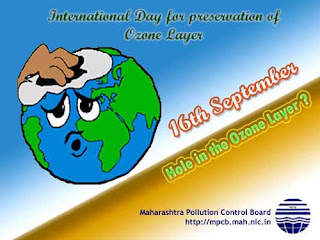International Ozone Day 16th September 2012
International Ozone Day 16th September 2012
Ozone is a gas that occurs both in the Earth’s upper atmosphere and at ground level. Ozone can be “good” or “bad” for your health and the environment, depending on its location in the atmosphere.Ozone occurs in two layers of the atmosphere. The layer closest to the Earth’s surface is the troposphere. Here, ground level or “bad” ozone is an air pollutant that is harmful to breathe and it damages crops, trees and other vegetation. It is a main ingredient of urban smog. The troposphere generally extends to a level about 6 miles up, where it meets the second layer, the stratosphere. The stratosphere or “good” ozone layer extends upward from about 6 to 30 miles and protects life on Earth from the sun’s harmful ultraviolet (UV) rays.Ozone is produced naturally in the stratosphere. But this “good” ozone is gradually being destroyed by man made chemicals referred to as ozone-depleting substances (ODS), including chlorofluorocarbons
(CFCs), hydrochlorofluorocarbons (HCFCs), halons, methyl bromide, carbon tetrachloride, and methyl chloroform. These substances were formerly used and sometimes still are used in coolants, foaming agents, fire extinguishers, solvents, pesticides, and aerosol propellants. Once released into the air these ozone-depleting substances degrade very slowly. In fact, they can remain intact for years as they move through the troposphere until they reach the stratosphere. There they are broken down by the intensity of the sun’s UV rays and release chlorine and bromine molecules, which destroy the “good” ozone. Scientists estimate that one chlorine atom can destroy 100,000 “good” ozone molecules.
High-Altitude “Good” Ozone
Protect yourself against sunburn. When the UV Index is “high” or “very high”: Limit outdoor activities between 10 am and 4 pm, when the sun is most intense. Twenty minutes before going outside, liberally apply a broad-spectrum sunscreen with a Sun Protection Factor (SPF) of at least 15. Reapply every two hours or after swimming or sweating.
Use approved refrigerants in air conditioning and refrigeration equipment. Make sure technicians that work on your car or home air conditioners or refrigerator are certified to recover the refrigerant. Repair leaky air conditioning units before refilling them.
Ground-Level “Bad” Ozone
Check the air quality forecast in your area. At times when the Air Quality Index (AQI) is forecast to be unhealthy, limit physical exertion outdoors. In many places, ozone peaks in mid-afternoon to early evening. Change the time of day of strenuous outdoor activity to avoid these hours, or reduce the intensity of the activity. For AQI forecasts, check your local media reports or visit: www.epa.gov/airnow
Help your local electric utilities reduce ozone air pollution by conserving energy at home and the office. Consider setting your thermostat a little higher in the summer. Participate in your local utilities’ load-sharing and energy conservation programs.
Reduce air pollution from cars, trucks, gas powered lawn and garden equipment, boats and other engines by keeping equipment properly tuned and maintained. During the summer, fill your gas tank during the cooler evening hours and be careful not to spill gasoline. Reduce driving, carpool, use public transportation, walk, or bicycle to reduce ozone pollution, especially on hot summer days. Use household and garden chemicals wisely. Use low VOC paints and solvents. And be sure to read labels for proper use and disposal.
TOP: The “good” ozone layer in the stratosphere protects life on Earth from the Suns harmful ultraviolet (UV) rays.
MIDDLE: Antarctic Ozone Thinning, extended out over 16 million square miles or about the same size as
North America.
BOTTOM: “Bad” ozone at ground-level is harmful to breathe and damages crops, trees, and other
vegetation.



Comments
Post a Comment